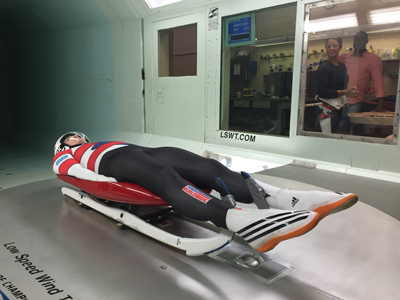When veteran USA Luge coach Wolfgang Schaedler left the program in 2010, the team lost more than a coach. It lost a man whose unique blend of athletic and engineering expertise influenced sled optimization for a generation.
Ever since then, the team has turned to data analytics to replace him.
Working with team sponsor and abrasives manufacturer Norton/Saint-Gobain, USA Luge is building a database full of every conceivable factor that could affect an athlete’s time down the course: weather, track conditions, biological nuances, sled design and strategic sled manipulations. The database includes nearly 60 variables and growing.
 |
Data is collected during a wind tunnel test.
Photo by: USA Luge |
The database has its origins in worldwide Olympic sponsor Dow’s work to help build a better sled, and the chemical company continues to tinker with new designs. But now, the database is playing a role in every decision luge athletes and coaches make, said Mark Grimmette, two-time Olympic medalist and sports program director for luge’s national governing body.
In a sport in which gold medals are decided by thousandths of a second, and infinitessimal changes in temperature can alter strategy, no stone is left unturned. They hope to comb the database for clues on how to individually optimize every race.
“When the coaching staff is at a track, and they see a certain type of weather, certain type of conditions, and certain type of track, they can set up the sled based on the information we’ve gathered in the database,” Grimmette said.
But before the database could spit out any useful insights, they had to develop sensors to gather all the data, generated during practice and trips to the San Diego Wind Tunnel. For instance, aerodynamic lead-weight supplier Vulcan GMS helped create a device to measure an athlete’s precise center of gravity while on the sled, and another one to more precisely measure the angle of the sled runners.
Luge remains a European-dominated sport, but Grimmette is optimistic that data can help the U.S. close the gap.
And for him personally, it’s a fulfilling new dynamic to the sport he loves.
“I got into the sport because you get addicted to the speed, and going through the curves and building the G-forces,” he said. “But the other part that’s attractive to me is the science behind it, and the physics behind it. And to be able to dive into the physics behind it is pretty exciting.”




